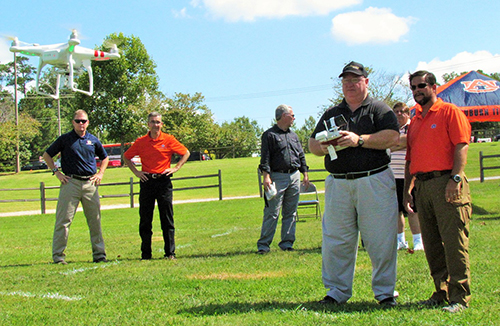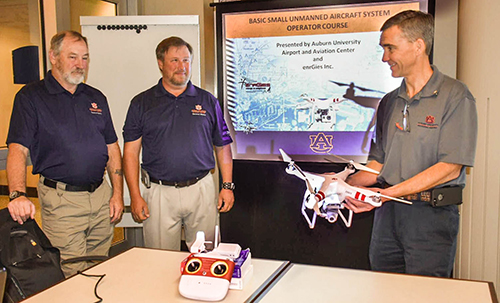Drone technology can benefit farmers, schools, industry
By Emmett Burnett
Look, up in the sky! It’s a bird. It’s a plane. It’s none of the above. “It” is a drone, hovering over Alabama skies.
Actually, ‘drone’ is not always the best choice of words. “We prefer ‘unmanned aircraft systems, or UAS,’” says Brandon Reed, a UAS instructor with Huntsville’s EnrGies Inc. “The word ‘drone’ has a bad reputation.”
Indeed it does. Drones conjure images of sky-spies, the creepy airborne camera controlled by that equally creepy next door neighbor. But good drones outweigh bad ones and UAS can enhance lives, and in some cases, save them.

Unmanned aircraft may soon be Alabama farmers’ flying tractors. Civil defense will call them to service for hurricane rescue. Forestry operations, wildlife management, bridge repair, and more will benefit from these flying computers. And what better place to learn how to harness the sky than the campus of the War Eagle.
Auburn teaching hands-on skills
Auburn University runs America’s first FAA-approved Unmanned Aircraft Systems Flight School. It teaches hands-on skills and beyond. Auburn focuses on federal regulations, legalities and UAS capabilities.
“We have taught aviation for over 80 years,” says Dr. William ‘Bill’ T. Hutto, director, Auburn University Regional Airport and Aviation Center. “Auburn sees enormous growth ahead for unmanned aircraft. Offering a course is a natural extension of what we’ve already done.”
Auburn built the course in conjunction with EnrGies Inc., Huntsville. “There is much more to flying remote aircraft than taking it out of the box, charging a battery, and pressing the ‘Go’ button,” says Phil Owen, EnrGies director of UAV (unmanned aerial vehicles) operations.
Owen worked with Dr. Hutto in building the course. They both love flying and preach safety. Owen notes that a UAV weighing 10 pounds, made of carbon fiber, with props spinning at 17,000 rpms is practically a flying buzz saw. “It is not a toy,” he says.
But the potential is enormous.
Saving time and money
 “In Alabama we see exciting uses ahead,” adds Dr. Hutto, “especially in precision agriculture.” He explained that a UAV flying over 1,000 acre farms can obtain data in minutes from the sky as opposed to hours from earth. Farmers receive data, pinpointing areas of concern — more water, less fertilizer, fungus treatments, and more — delivered from an airborne drone via email.
“In Alabama we see exciting uses ahead,” adds Dr. Hutto, “especially in precision agriculture.” He explained that a UAV flying over 1,000 acre farms can obtain data in minutes from the sky as opposed to hours from earth. Farmers receive data, pinpointing areas of concern — more water, less fertilizer, fungus treatments, and more — delivered from an airborne drone via email.
With aerial applications including surveying, R&D, powerline/pipeline/bridge inspections, wildlife management, and support to first responders — no pun intended — UAVs are looking up.
Looking ahead, Auburn is considering ways to incorporate unmanned aircraft into the school’s curriculum, including journalism, engineering and aerospace. As Dr. Hutto says, “the sky is the limit.”
Auburn’s course met FAA approval in April 2015 and held its first session the following September. The course will evolve, pending FAA rulings expected in 2016.
From Lee to Pike County — 62 miles as the drone flies — Troy University has a similar approach. “It is the first Alabama school to offer a minor in Unmanned Aerial Systems,” says Al Allenback, vice president for airport planning and engineering at Goodwyn Mills Cawood in Montgomery. “Troy University prepares future UAS operators, policymakers, and CDOs — Chief Drone Officers.” Having the title ‘Chief Drone Officer,’ is pretty cool too.
$82 billion impact predicted
Allenback claims that by 2025, the UAS industry will have an $82 billion impact across government, military, and commercial operations. It will employ more than 100,000 people. Troy, Auburn, and colleges to follow, want to ensure that Alabama’s drone economy takes off — just as Troy’s drone does.
“We’ve had one for the last two years,” recalls Cliff Lusk, Troy University spokesperson. “It’s a great way to keep alumni, students, and others connected. However, the biggest reactions occur when people see the beauty of the campus (UAS photographed) from up high.”
Awesome aerial photography is impressive, but saving time sealed the deal for John O’Dell, an insurance-building inspection company owner in Semmes, AL. “It decreases the times I climb ladders to roofs,” he says. “With a lot of house tops to inspect, I can do in 10 minutes with my drone what takes hours without it.”
Admittedly, unmanned aircraft have a wow factor. “It really is amazing technology,” adds Phil Owen. UAVs carry onboard computers, video/still shot cameras and satellite GPS. And that’s the standard package. Try the deluxe model, implemented with infrared sensors, reconnaissance capabilities, weather-data forecasters, tracking devices, or stuff the U.S. military can or cannot confirm nor deny.
It flies without an onboard human pilot up to 80 mph, 400 feet high, legally. And anybody can buy one. That is not always good.
Citing drone crashes into electrical substations, near misses with airplanes, and launches that never return, Owen adds, “These things are not as easy to fly as some may think. You must know what you are doing.” The FAA agrees.
In October 2015, U.S. Transportation Secretary Anthony Foxx and the FAA announced that non-commercial drones will be registered and regulated just like commercial ones. “As far as the FAA is concerned, drones are no different than airplanes,” says Brandon Reed. “More rulings will be announced in 2016. Count on it.”
More unmanned aircraft are coming, too. It is good news for Alabama’s farmers, educators, industry and businesses, who say bring it on. UAVs are clear for takeoff.
Co-ops see help for maintenance, storm assessment
Electric utilities are looking toward UAVs to reduce costs, improve safety, and increase reliability and response times across their transmission and distribution systems, according to a recent article in Intelligent Utility.
UAVs can help with inspections of overhead transmission and distribution lines, storm damage assessment, outage management/response, substation inspection, asset monitoring, and even vegetation management, the article noted.
The possibilities offered by drones have attracted the interest of several Alabama electric co-ops, says Mike Temple, AREA director of training and risk management. Temple has been asked to serve on an NRECA committee to study the use of UAVs in cooperatives across the country
“We have been talking and sharing information with several of our neighboring statewide associations who’ve been using UAVs in limited applications,” says Temple, who is keeping an eye on FAA requirements that may continue to change. Nevertheless, “the potential for cost savings and benefits to our members is definitely there.”






